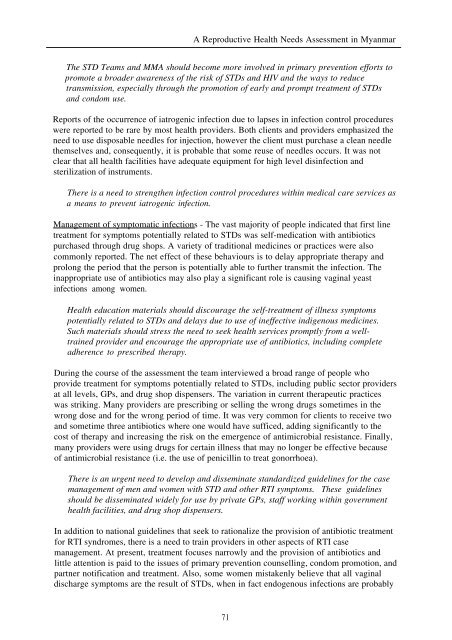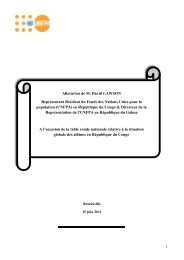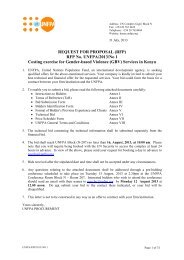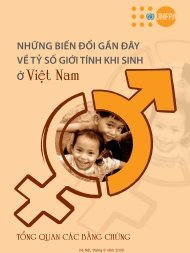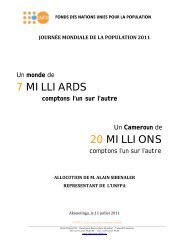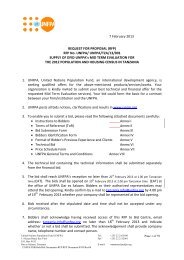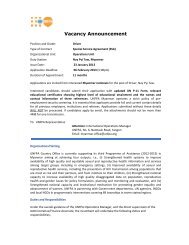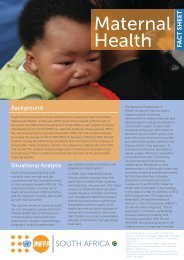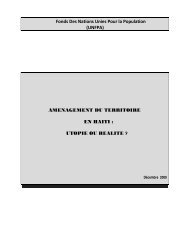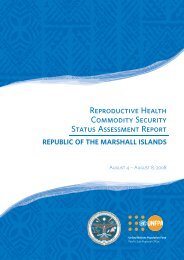A reproductive health needs assessment in Myanmar
A reproductive health needs assessment in Myanmar
A reproductive health needs assessment in Myanmar
You also want an ePaper? Increase the reach of your titles
YUMPU automatically turns print PDFs into web optimized ePapers that Google loves.
A Reproductive Health Needs Assessment <strong>in</strong> <strong>Myanmar</strong><br />
The STD Teams and MMA should become more <strong>in</strong>volved <strong>in</strong> primary prevention efforts to<br />
promote a broader awareness of the risk of STDs and HIV and the ways to reduce<br />
transmission, especially through the promotion of early and prompt treatment of STDs<br />
and condom use.<br />
Reports of the occurrence of iatrogenic <strong>in</strong>fection due to lapses <strong>in</strong> <strong>in</strong>fection control procedures<br />
were reported to be rare by most <strong>health</strong> providers. Both clients and providers emphasized the<br />
need to use disposable needles for <strong>in</strong>jection, however the client must purchase a clean needle<br />
themselves and, consequently, it is probable that some reuse of needles occurs. It was not<br />
clear that all <strong>health</strong> facilities have adequate equipment for high level dis<strong>in</strong>fection and<br />
sterilization of <strong>in</strong>struments.<br />
There is a need to strengthen <strong>in</strong>fection control procedures with<strong>in</strong> medical care services as<br />
a means to prevent iatrogenic <strong>in</strong>fection.<br />
Management of symptomatic <strong>in</strong>fections - The vast majority of people <strong>in</strong>dicated that first l<strong>in</strong>e<br />
treatment for symptoms potentially related to STDs was self-medication with antibiotics<br />
purchased through drug shops. A variety of traditional medic<strong>in</strong>es or practices were also<br />
commonly reported. The net effect of these behaviours is to delay appropriate therapy and<br />
prolong the period that the person is potentially able to further transmit the <strong>in</strong>fection. The<br />
<strong>in</strong>appropriate use of antibiotics may also play a significant role is caus<strong>in</strong>g vag<strong>in</strong>al yeast<br />
<strong>in</strong>fections among women.<br />
Health education materials should discourage the self-treatment of illness symptoms<br />
potentially related to STDs and delays due to use of <strong>in</strong>effective <strong>in</strong>digenous medic<strong>in</strong>es.<br />
Such materials should stress the need to seek <strong>health</strong> services promptly from a welltra<strong>in</strong>ed<br />
provider and encourage the appropriate use of antibiotics, <strong>in</strong>clud<strong>in</strong>g complete<br />
adherence to prescribed therapy.<br />
Dur<strong>in</strong>g the course of the <strong>assessment</strong> the team <strong>in</strong>terviewed a broad range of people who<br />
provide treatment for symptoms potentially related to STDs, <strong>in</strong>clud<strong>in</strong>g public sector providers<br />
at all levels, GPs, and drug shop dispensers. The variation <strong>in</strong> current therapeutic practices<br />
was strik<strong>in</strong>g. Many providers are prescrib<strong>in</strong>g or sell<strong>in</strong>g the wrong drugs sometimes <strong>in</strong> the<br />
wrong dose and for the wrong period of time. It was very common for clients to receive two<br />
and sometime three antibiotics where one would have sufficed, add<strong>in</strong>g significantly to the<br />
cost of therapy and <strong>in</strong>creas<strong>in</strong>g the risk on the emergence of antimicrobial resistance. F<strong>in</strong>ally,<br />
many providers were us<strong>in</strong>g drugs for certa<strong>in</strong> illness that may no longer be effective because<br />
of antimicrobial resistance (i.e. the use of penicill<strong>in</strong> to treat gonorrhoea).<br />
There is an urgent need to develop and dissem<strong>in</strong>ate standardized guidel<strong>in</strong>es for the case<br />
management of men and women with STD and other RTI symptoms. These guidel<strong>in</strong>es<br />
should be dissem<strong>in</strong>ated widely for use by private GPs, staff work<strong>in</strong>g with<strong>in</strong> government<br />
<strong>health</strong> facilities, and drug shop dispensers.<br />
In addition to national guidel<strong>in</strong>es that seek to rationalize the provision of antibiotic treatment<br />
for RTI syndromes, there is a need to tra<strong>in</strong> providers <strong>in</strong> other aspects of RTI case<br />
management. At present, treatment focuses narrowly and the provision of antibiotics and<br />
little attention is paid to the issues of primary prevention counsell<strong>in</strong>g, condom promotion, and<br />
partner notification and treatment. Also, some women mistakenly believe that all vag<strong>in</strong>al<br />
discharge symptoms are the result of STDs, when <strong>in</strong> fact endogenous <strong>in</strong>fections are probably<br />
71


